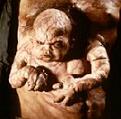- Adbot
-
ADBOT LOVES YOU
|

|
|
#
¿
May 10, 2024 01:39
|
|
- Bouillon Rube
- Aug 6, 2009
-



|
Thats a cool find for a coin star bin. Ron Don Volante got it about right when he said a couple bucks. The coin has some crud on it, lots of scratches, and is pretty beat up even though it does have some good defined details left. It's not something a collector would seek out, but just about any pre-German Empire coin that isn't worn flat is usually worth at least 1-3 bucks depending on how you are selling it.
Prior to the unification of the German States to form the German Empire in 1871 for the Franco-Prussian War, Prussia was by far the largest and most dominant of the German States. As a result, the newly formed German Empire would adopt the Prussian eagle as the coat of arms for the Empire, as well as make the King of Prussia the leader of the new German Empire. As a result, Prussian coinage was the most minted and widely distributed coinage from that period. Even though the coin doesn't say Prussia, someone at the time would immediately recognize the coin as Prussian because of the eagle on the front. The coin has the single headed eagle looking left with the sceptre and orb in its claws, which is an image adopted from the Holy Roman Empire (Catholic Church) for use by Prussia hundreds and hundreds of years before. Prussia was part of the Holy Roman Empire until it dissolved in 1806, but there wasn't much confusion in the symbolism because the Holy Roman Empire had long before started using double headed eagle as their symbol. When the Holy Roman Empire dissolved, Austria was allowed to continue to use the double headed eagle (and still does to this day), but the rest of the German States did not and all began using their own coats of arms.
Old German coin collectors usually fall into one of two categories. One group of people tends to only collect larger denomination gold and silver coins like thalers and ducats. They are very ornate and that time period/region probably had the best combination of the desire to create beautiful ornate coins and the ability to do so, when compared to other places and times in history. The other type of collector is one that tries to collect coins of as many different types from as many different issuing authorities in the German States/Holy Roman Empire region as possible. If you go back to the 1500s, there have been over 300 different issuing authorities, often called German States, that made their own unique coins. The second type of collector would be interested in your coin, but since there are so many of the coins it's not as high of a value as some of the others.
There. That's way more information than you probably needed.
By the way, I made a for sale thread on German Coins and world coins in the SA mart. I have a bunch of world coins I'll be listing if the thread generates any interest.
Thanks for all the info! I don't have much intention of selling it; was just curious if it was worth anything.
Any idea of why they divided their currency into 360 units? Obviously there are 360 degrees in a circle, but I don't really see how that would translate naturally into monetary matters.
|
 #
¿
Jul 2, 2013 19:53
#
¿
Jul 2, 2013 19:53
|
|








